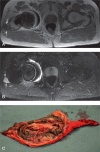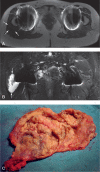Comparison of extracapsular pseudotumors seen in magnetic resonance imaging and in revision surgery of 167 failed metal-on-metal hip replacements
- PMID: 24954485
- PMCID: PMC4164864
- DOI: 10.3109/17453674.2014.934189
Comparison of extracapsular pseudotumors seen in magnetic resonance imaging and in revision surgery of 167 failed metal-on-metal hip replacements
Abstract
Background and purpose: Magnetic resonance imaging (MRI) is important for detecting extracapsular pseudotumors, but there is little information on the accuracy of MRI and appropriate intervals for repeated imaging. We evaluated the sensitivity and specificity of MRI for detecting pseudotumors in 155 patients (167 hips) with metal-on-metal (MoM) hip arthroplasties that failed due to adverse reactions to metal debris (ARMD).
Methods: Preoperative MRIs were performed with two 1.5 T MRI scanners and graded by a senior musculoskeletal radiologist using a previously described MRI pseudotumor grading system. Revision findings were retrieved from surgical notes, and pseudotumors were retrospectively graded as fluid-filled, mixed-type, or solid.
Results: The sensitivity of MRI was 71% and the specificity was 87% for detecting extracapsular pseudotumors. The sensitivity was 88% (95% CI: 70-96) when MRI was performed less than 3 months before the revision surgery. Interestingly, when the time that elapsed between MRI and revision was more than 1 year, the sensitivity calculated was only 29% (95% CI: 14-56). Comparison between MRI and revision classifications gave moderate agreement (Cohen's kappa = 0.4).
Interpretation: A recent MRI predicts the presence of a pseudotumor well, but there is more discrepancy when the MRI examination is over a year old, most likely due to the formation of new pseudotumors. 1 year could be a justifiable limit for considering a new MRI if development of ARMD is suspected. MRI images over a year old should not be used in decision making or in planning of revision surgery for MoM hips.
Figures



Similar articles
-
Preoperative Risk Factors Associated With Poor Outcomes of Revision Surgery for "Pseudotumors" in Patients With Metal-on-Metal Hip Arthroplasty.J Arthroplasty. 2016 Dec;31(12):2835-2842. doi: 10.1016/j.arth.2016.05.034. Epub 2016 May 27. J Arthroplasty. 2016. PMID: 27387480
-
Good sensitivity and specificity of ultrasound for detecting pseudotumors in 83 failed metal-on-metal hip replacements.Acta Orthop. 2015 Jun;86(3):339-44. doi: 10.3109/17453674.2014.1001970. Epub 2015 Jan 13. Acta Orthop. 2015. PMID: 25582840 Free PMC article.
-
Adverse reactions to metal debris occur with all types of hip replacement not just metal-on-metal hips: a retrospective observational study of 3340 revisions for adverse reactions to metal debris from the National Joint Registry for England, Wales, Northern Ireland and the Isle of Man.BMC Musculoskelet Disord. 2016 Dec 13;17(1):495. doi: 10.1186/s12891-016-1329-8. BMC Musculoskelet Disord. 2016. PMID: 27955657 Free PMC article.
-
[Pseudotumors caused by hip prostheses].Duodecim. 2015;131(9):848-53. Duodecim. 2015. PMID: 26237883 Review. Finnish.
-
MRI Characteristics of Adverse Local Tissue Reactions Associated With Intraoperative Tissue Damage and Poor Revision Surgery Outcomes: A Systematic Review.J Am Acad Orthop Surg. 2021 Oct 15;29(20):e1025-e1033. doi: 10.5435/JAAOS-D-20-00793. J Am Acad Orthop Surg. 2021. PMID: 33201043
Cited by
-
The utility of repeat ultrasound imaging in the follow-up of metal-on-metal hip arthroplasty patients.Ann R Coll Surg Engl. 2016 Feb;98(2):143-9. doi: 10.1308/rcsann.2016.0052. Epub 2016 Jan 7. Ann R Coll Surg Engl. 2016. PMID: 26741659 Free PMC article.
-
Imaging in peri-prosthetic assessment: an orthopaedic perspective.EFORT Open Rev. 2017 May 11;2(5):117-125. doi: 10.1302/2058-5241.2.160058. eCollection 2017 May. EFORT Open Rev. 2017. PMID: 28630749 Free PMC article.
-
Gluteal muscle fatty atrophy is not associated with elevated blood metal ions or pseudotumors in patients with a unilateral metal-on-metal hip replacement.Acta Orthop. 2016 Feb;87(1):29-35. doi: 10.3109/17453674.2015.1094713. Epub 2015 Oct 1. Acta Orthop. 2016. PMID: 26427902 Free PMC article.
-
Which imaging modality is most effective for identifying pseudotumours in metal-on-metal hip resurfacings requiring revision: ultrasound or MARS-MRI or both?Bone Joint J. 2016 Jan;98-B(1):40-8. doi: 10.1302/0301-620X.98B1.36746. Bone Joint J. 2016. PMID: 26733514 Free PMC article.
-
Management Guidelines for Metal-on-metal Hip Resurfacing Arthroplasty: A Strategy on Followup.Indian J Orthop. 2017 Jul-Aug;51(4):414-420. doi: 10.4103/ortho.IJOrtho_230_17. Indian J Orthop. 2017. PMID: 28790470 Free PMC article.
References
-
- Almousa SA, Greidanus NV, Masri BA, Duncan CP, Garbuz DS. The natural history of inflammatory pseudotumors in asymptomatic patient... . Clin Orthop. 2013;471(12):3814–21. - PMC - PubMed
-
- Anderson H, Toms AP, Cahir JG, Goodwin RW, Wimhurst J, Nolan JF. Grading the severity of soft tissue changes associated with metal-on-met... . Skeletal Radiol. 2011;40(3):303–7. - PubMed
-
- Bozic KJ, Kurtz S, Lau E, Ong K, Chiu V, Vail TP, Rubash HE, Berry DJ. The epidemiology of bearing surface usage in total hip arthroplasty in t... . J Bone Joint Surg (Am) 2009;91(7):1614–20. - PubMed
-
- Chang EY, McAnally JL, Van Horne JR, Statum S, Wolfson T, Gamst A, Chung CB. Metal-on-metal total hip arthroplasty: Do symptoms correlate with MR ima... . Radiology. 2012;265(3):848–57. - PubMed
-
- Ebreo D, Bell PJ, Arshad H, Donell ST, Toms A, Nolan JF. Serial magnetic resonance imaging of metal-on-metal total hip replacemen... . Bone Joint J. 2013;95-B(8):1035–9. - PubMed
Publication types
MeSH terms
Substances
LinkOut - more resources
Full Text Sources
Other Literature Sources
Medical
